On my birthday (Sept) someone posted on the Salt Spring exchange about trekking in Nepal. June noticed it and said Keith (my 19-year-old son) and I should go. I emailed the person and met up. He gave me the low down on the trek he was proposing and that set the wheels in motion for our trip. He said it would be more than just a teahouse trek but I had no prior knowledge of trekking in Nepal and did not know what he was talking about. That afternoon I tore into the internet for about 10 hrs reading and viewing all I could find out. The next day we booked our flights on Expedia and were going. I made up a rough checklist of things that had to be done with passports being at the top of the list.
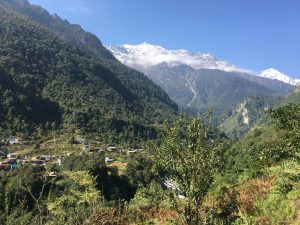
Some things about the Salt Spring real estate market are very predictable. When the winter rain hits about mid-October the buyers are about as scarce as a sunny day. It’s a good time to hit the road. We planned on leaving Salt Spring on the 21 of October and not returning until about the 16 of November. All the sites I had read about trekking in Nepal said you would need a minimum of two weeks with three being optimum.
Where to go? After reading over all I could, I discovered that the Annapurna circuit was about perfect for first-time trekkers. It’s challenging but not totally isolated and we could go without a guide and or porters. To me, this is what I was looking for. As a hiker who subscribes to ultralight hiking methods as much as possible, it seemed perfect.
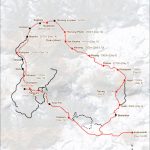
The Annapurna circuit is a classic tea house trek. Each town has guest houses you can stay in and the houses cook all the meals for you. So without food, our packs would be very light. Why would we need a porter? Who needs extra stuff? Less stuff means less weight which means faster walking speeds and more energy. What about a guide? As an experienced hiker and backcountry traveller did I really need one? After reading over all the trip advisor posts I came to the conclusion a guided tour might not be the best way to go. More about this later.
What to take with us? Being bent on going light and convinced that ultralight hiking is the same anywhere on the globe we just took the very basics. Trail running shoes, 2 extra pairs of socks, one extra underwear and some new kit we needed including a down sleeping bag and a down jacket. Keith and I popped into the MEC store in Victoria and bought our MEC Tremblant down jackets ($220) which we knew were going to be on the higher end of what we might need but this is one of those things that it’s just not worth skimping on. Shorts, Adidas pants, T-shirt, merino wool sweatshirt and a hoodie rounded off our kit list. I had my 30 Liter pack and Keith who wanted a few extra tops took my older MEC 60 Liter pack. Mine weighed in at 7kg and his was about 12kg.
The flight was a long one going from Vancouver to Guangzhou China and then on to Kathmandu. This was my first time in the new Boeing 787 Dreamliner and what a plane it is. It’s the little things that make it a joy to fly in like the humidity level is 15%, not the standard 4% and the pressure being 6000 ft not the standard 8000 ft. The flight was long but not that bad. The worst part was Southern China connection at the terminal in the massive airport in Guangzhou.
I had been here 25 years ago when it was a dusty little town with a one-terminal airport and the connections were better back then. Trust the one-party country to screw up a simple connection. What would they do if they had the volume of Chicago? 1.3 billion people and only two working the check-in counter! Needless to say, the price was right, $1200 return, so even with the long slow line of 500 odd people in Guangzhou it did not matter.
We landed in Kathmandu (KTM) at about 10:15 pm and faced another long line to pay our entrance tax of $40 bucks. The good news was that I had filled out and printed our visa paperwork online which made it easy for us. Here is the link to fill out the form online. Some were scrambling at the terminal trying to fill out the odd form. Most trekkers who stay in Kathmandu stay in Thamel and none of the hotels have their address on their websites and this was needed for the form. It had taken me some trying to figure this out at home but sure glad I had it now.
The airport in Kathmandu is small and compact and busy. The funny thing was that behind the customs guards was a TV on the wall and playing was Gold Rush and Todd Hoffman was there in his excavator. Not what I was expecting but pretty funny seeing the Yukon on TV halfway around the world. Once we made it out of the labyrinth of the airport we jumped into a cab after the driver said he knew where the hotel was. As it turned out he got us close but could not find the place. I had booked it on Expedia after reading over the reviews. After multiple stops and a grand tour of the city we found the hotel and found our room which was better than expected.
In the a.m. I was up at first light and down to the lobby for breakfast and coffee. An experienced trekker from the US of A was there and told me to get over to the Timms office for the opening at 8:30 am. He said there would be no line and it would go fast. He recommended we go via pedal rickshaw. We did not set a price with the pedal rickshaw driver which was a good lesson in Nepal negotiations. Setting the price before you get into a cab or buy anything is probably a smart move.
At the Timms office, we had the required photos and all. We were just short a little local currency. Not to worry there was an ATM there. I’m not an ATM user, ever. I had ordered a new card and had lessons at the local branch. I had always thought I was doing my part employing tellers and never bought into the idea of using an ATM. So in I go and “card blocked” comes up. Luckily our trust rickshaw driver was there waiting and offered to take me to another bank. After going to three other banks I realized I was out of luck. I had even told our bank here I was going to Nepal and they said I did not need to notify them it was all good. June had my phone back on Salt Spring and did get a text saying someone was trying to use our ATM card.
Luckily Keith’s card worked and he took out enough cash to get our Timms card and Annapurna permit. The rickshaw driver was kind enough to take us back to our hotel and then asked for 50 USD. Needless to say, we did not pay this but did pay him a fee of 1500 NPR. Which was fair. The American told me he paid 400 to go there and back.
With that out of the way, the other big task we had to do in KTM is changing our money from USD to NPR. One big advantage to signing up for a guided tour of the Annapurna Circut is the guides pay all the bills. You just pay the guide company before you leave KTM. Self-guided people have to pay in cash for everything. We had brought with us about 1400 USD. I had calculated we would need about 5000 Rupee per day. The exchange rate is about 100 to one.
In Thamel, there are lots of little exchange wickets that will exchange cash but the thought of pulling out a grand in the middle of the tourist area was a little scary. I also thought that a regular bank would offer a better exchange rate. After my rickshaw tour, I did kind of know where some banks were. The plan was to be discreet and change $500 at a time. OMG at the first bank I felt like a bank robber. It was all so cloak and dagger casually pulling out $500 and then the manager had to see it and the security guards and it seemed as if everyone else who happened to be in the bank knew about it. The wad of cash they handed back was about an inch thick. We got out of Dodge fast and made tracks out of the area with cash in hand.
Luckily the next bank was a little more conducive to changing money and offered a bit of privacy to its clients in line. Back at the hotel, we divided up the loot. We had about 130,000 in 500 NPR notes. We had too much cash for our passport money belts. We ended up putting most of it in the bottom of our packs. The banks did offer a way better exchange rate than the money wickets. At the end of the trip, we had to exchange $100 dollars and only got 9,400 NPR.
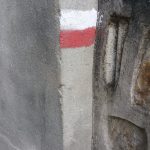
The other two things we had to pick up in KTM were a map and a guidebook. I had downloaded Andrees de Ruiter and Prem Rai 2011 abbreviated guide but wanted to find his latest edition guidebook. The book is called Trekking the Annapurna Circuit “the new Natt-trails which avoid the road”. Andrees has been trekking in Nepal for 30-plus years and was the one who started marking the trails with red and white paint. The book and a map, we bought the 1:80,000 Around Annapurna map is indispensable. One has to have these if you’re going to self-guide and do not want to just walk down the jeep trail.
So the next morning we were off to the Gongabu (new) bus park. The cab driver charged us 1000 NPR for the trip. The bus park was just like the videos of it. The ticket windows were used to seeing trekkers. It was only 720 NPR for our tickets. At the bus, we met some others heading out on the same trek. The co-driver of the bus did try and extort 100 NPR out of us for a tourist tax. We did not pay him which might have been a mistake – we were assigned to the back seats of the bus.
The driver was horrendous, somehow he felt compelled to pass every car and/or truck on every corner after giving the horn signal. The music was a mixture of Indian pop music played loud and maxing out the 20plus-year-old speakers. I don’t know if it was the back seat, the music, the nonstop horn, the diesel smell and or the heat that made me totally nauseous. The bus ride went on and on. I had thought it would just be 4 hrs but it turned out to be close to 10 hrs.
Finally, we arrived in Besisahar. The bus Gremlin, as Keith liked to call him, was busy extorting an unloading fee so I climbed up top and retrieved our packs. Some of the other people on the bus had a guide and the guide secured a jeep going to Syange (1100m). It seemed like a logical place to start so we piled into the jeep. It was about 4pm and raining so the thought of getting a little jump at the bottom of the circuit seemed like a good idea at the time.
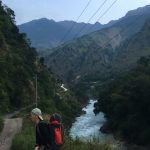
After our first night in a teahouse we were up before the sun and on the trail at first light. The reason I liked the start here is the elevation at 1100m is basically at around the lower elevation and where the trail just starts to climb. Our goal was to go slow and take in all the elevation at a walking pace. That first morning was so nice and pleasant. Finally, we were just walking or trekking. It took a lot to get to this point on the 25 of October.
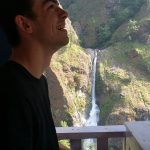
We walked to Jagat and found a tea house and ordered breakfast. It seemed to take forever to get our food and this was our first introduction to the menus. Most of the tea houses have the same menus and charge the same approved prices. Finally, we ate and got back onto the road and looked for our first NATT trail. All morning we had not seen a jeep and or motorbike – most do not seem to hit the road until 8 am or so.
We stopped at Cayamche for pop and some more water. We had the owner’s son fill up one of our 2L Platypus collapsible water bottles. Once he gave it back to us we dropped in a chlorine tab. The water was crystal clear so we only used one tab. Once the water sat for 30 min or so we would transfer the water to our Lifestraw water bottles which are fantastic. We had used them on the West Coast Trail this last May. Every day on the trip we did all of our water this way. We never once bought a bottle of water. We did buy pops but did try and buy pop in the glass bottles.
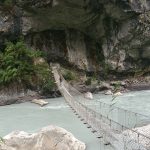
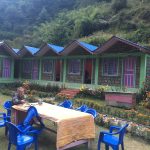
We walked to Tal and had lunch. At Tal, we met up with those that were on the Jeep and bus. The guides had them all in a panic that there would be no rooms in Dharapani (1860m) and they should spend the night there. It was about 1 in the afternoon when Keith and I set off. Once we got to Dharapani we realized the town was basically empty and all the owners of the various tea houses were out in front of their tea houses hailing clients. The place we stayed at here was the best tea house of the trip. It was clean, had a real toilet, hot gas shower, and excellent food. The couple who run the Crystal Hotel and Restaurant tea house are very sweet. That night we met up with two from the UK who were on a guided tour.
The next day was going to be interesting – it would be another NATT trail excursion off the main road. The two ladies from the UK left just after us and we expected them to cross the river and follow us onto the NATT trail but they did not. Their guide took them right up the jeep trail. This was our first witness of the guides missing the boat and not following the excellent NATT trail.
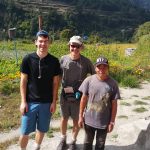

The trail that we followed was so cool. It ended up coming out to this pristine bright pink farm/tea house near Nasku. The farmer spoke great English and was a treasure trove of info. He had just built the tea house and it had been going great. He was surprised by the number of people who just wanted to hang out and work for free on the farm. Most do not see these little spots because the guides prefer the jeep trail. If I do make it back I do plan on staying at this tea house for a week or so.
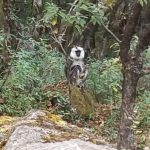
After Danakyu (2300m) we found the red and white markers after turning left – not right – on the road after the wooden bridge. Andree says this in the book and we almost missed it. The trail is actually about a thousand odd steps here that go up and up. About halfway up we met a couple of Canadian Doctors from Toronto. One worked in emergency and the other at the Children’s hospital in TO. This is where we saw a family of monkeys in the woods. It was really surreal to see them in their natural habitat.
The doctors, Keith and I had lunch in Timang where we meet a French expedition that was going to Nar which was a restricted area, guided expeditions with camping and cooking gear only. After lunch, we pressed on to Chame (2670m) where we spent the night. One of the doctors had done the trip before and knew of a hot spring. It was very hot and worth the dip.
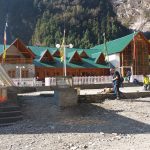

The next day we jumped back on the NATT trail at Talekhu and then went on to Bhratang (2850m). This was the only NATT trail we missed. I do not know if it was because of the apple orchard or not. At Bhratang there is a massive 60 acre apple orchard which was so interesting to see considering we come from an island that grows 200 different types of apples and has a massive apple festival in the fall. The apple orchard is a great example of sustainable economic development.
After lunch in Dhikur Pokhari (3060m) we headed off the jeep track for what would be a long detour. That night we stayed in Upper Pisang (3300m). Keith was definitely not feeling good. He had a cold. At elevation, any cold and or respiratory problem is compounded because of the lack of oxygen in the air.
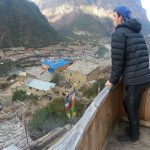
The next day we set off early thinking we would go to Manang or so. At first, all was fine we were enjoying the upper thinner forest which reminded me of parts of the interior of BC. About 3 km from Upper Pisang you come to a big hill you have to climb to get to Ghyaru (3670m). The hill just totaled poor Keith. He was sucking wind and not doing well at all. It took us a few hours to get up to Ghyaru. Once there, we found a tea house and checked in. It was about noon and Keith just crashed.
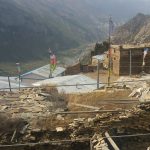
I went out and explored the area and town. There was light snow and a strong wind. At one point on the outskirts of town, I ran into a person we had met earlier on the trail. He was from San Francisco, had never done any hiking ever before and was going to set off in the snow for the next town. I told him he should reconsider because if the light snow becomes heavy it’s going to be a long 5km slog to Nawal. He set off in the snow. I half expected to find him dead in the a.m. The Annapurna Hotel was about as rustic of a tea house one can find but was clean. Note to Andrees yes there is new foam on the beds. The next morning Keith seemed refreshed. He did sleep for about 18 hrs or so which is not uncommon for a growing teen.
It was a coolish morning when we set off for Ghyaru (3370m) after a large pot of lemon tea and breakfast. All in the Annapurna Inn was the most reasonable place we stayed at costing us about 2000 NPR for my lunch, dinner, and breakfast for both. I’m glad I had the afternoon to just walk around Ghyaru finally I found myself on Nepal time and not in the rush of the modern world. It was interesting seeing first hand a higher altitude agrarian village. Ghyaru is not on the top of most trekkers list of places to see but it’s well worth the visit.
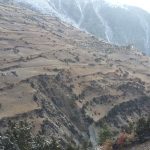
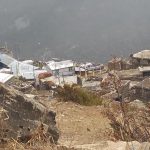
On the way to Nawal we came across the Super View Restaurant tea shop/bakery. The proprietor was a true gem who was chatty and interesting. He enjoyed telling us the woes of the Humde airport below. Apparently, there has been no airplanes land for 9 years. He was thrilled to show us his bakery – oven and all. Once we found out they actually baked the cinnamon rolls there I think we bought six of them. The owner is quite a salesman.
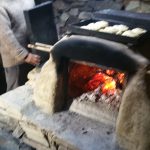
We pushed on to Nawal and had brunch with two men from Belgium who both work at the Volvo plant there. After a rather expensive brunch of porridge and tea (1100NPR), we set off through the pine forest to Julu. This is where the NATT trail has had some damage done to it. I’m not sure why the markers have been hammered off the rocks and or chopped out of the trees. According to the book, this was a not to miss trail and I wanted to see it.
Most hikers head south at Julu to the road and go through Mugje but I wanted to see what was billed as a spectacular bench. The trail did show up on my GPS, OpenStreetMap on my old trusty Samsung note 4, so we pushed on and up. Keith was not happy going up 300 meters onto a trail that was not really there anymore. At one point he threatened to mutiny. He was not doing well and the cold was back. I pushed on to the bench and went back for his pack. He was a little shocked to see his 36 years his senior father carry his pack to the top. Again it was snowing and windy but the bench was spectacular and amazing just like Andrees said it would be.
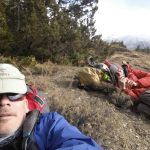
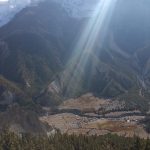
The trail has been abandoned and there was no sign of any footprints on it. I know this because one of my favorite TV shows is Mantracker. We found a nice little bit of dry ground out of the wind and took a much-needed break. Keith ate some of his gel which made him feel better. Nothing like a shot of pure sugar. The bench is about 2km long and ended up on a goat track down the other side that was terrifying. It was washed out in various spots and not for those that do not like sheer drops of 100m or so. It proved to be a good warm-up for later in the trip. The trail comes out at the blue and white marked ice lake trail that many take to acclimatize to the altitude and continues to Bhraka (3360m). We were both exhausted and stopped here. It was our first big tea house and not nice. It had all the charm of any Greyhound bus terminal in small-town BC.
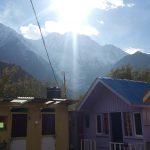
The next morning we got up early and walked the 3km to Manang (3540m) and found what was to be one of the better, smaller, tea houses. We heard about a high altitude medical lecture at 3 pm put on by Himalayan Rescue Association Nepal. We also took the chance to stock up on trail food such as cookies and chocolate bars. Keith also bought another sleeping bag to use as a liner inside the down one he had. He had been cold and for the $30 it was worth making sure he was warm at night. At the medical clinic, we did get him some cold meds and throat lozenges. The medical lecture was really well done by a young Irish Doctor, Andrew Gerald Mahon, who went over it all in detail.
He also gave us the scoop on Heli rescue. It seems as if most of the lodge owners could call in a chopper and have one airlifted off the hill but good luck getting your insurance company to cover the 5k USD bill. Every day we heard about 5 or 6 choppers making a run into one of the various lodges and or helipads. Heli rescue is a controversial subject that is covered on the various TripAdvisor forms. The rumor is overpayments are made from the Heli companies back to the guides and or lodge owners. Who knows – living on a small island I have heard more than my fair share of rumors! I’m sure if you need one it will be there and if you’re really sick it could save your life.
Manang is the spot where all the guided tours stop for a rest day. It’s the major town in the area. It’s also the at the meeting spot of two major river valleys. For those on most guided tours, they head on to Thorung La Pass from here but we wanted to go to Tilicho Lake.
In Manang, we meet Canadian mountain bike champ Cory Wallace from Victoria. He was there practicing for the Yak Attack bike race around the Annapurna Circuit. We were hoping to see part of the race but it goes by so fast and if one does not have some kind of live feed where the racers are it’s almost impossible to track the race. Corry has won the race two years in a row. Go Canada Go.
The trail to the lake is beautiful and some come from around the world just to see the lake. In Nepal, the lake trip is heavily promoted and many younger Nepalese drive to Manang in jeeps and hike from there to the lake. During the extensive medical lecture on altitude sickness, the doctor mentioned the Nepalese from Kathmandu and their quest for the lake. He said they had treated many of them. That morning we walked through Khangsar and made it as far as a group of tea houses in a row along the trail. We ended up getting one of the last rooms that afternoon.
It was only about 4 or 5 km to Tilicho lake base camp but I really did not want to walk massive and steep scree fields in the afternoon. Salt Spring has very similar talus rock outcrops that are not stable in freezing and thawing conditions. The conditions here are ripe for rock slides. Cold freezing at night with warm winds in the afternoon. It’s best to walk the rock slide area in the early a.m.
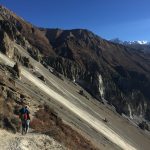
We got up early and started the day’s trek. It was somewhat terrifying. I have walked a lot of scree fields on Vancouver Island and or Salt Spring but nothing the size of these. It had to be 500 m up and 500 m down. I really do not know if you could save someone if they were to fall. It’s one of those things just walk and don’t look up and or down. This is where trekking poles give you the edge. The old 3 points of contact at any given time can be adhered to. With a pack and no trekking poles, it would be scary and you would be top heavy. Personally, I always use poles – I can not hike without them. Once you get used to them, it is hard to go without.
We make it to the lodge and checked in at 10 a.m., had lunch and a hot shower. Our friends from Belgium were there and managed to get the showers working. The on-demand propane shower systems are great if they are working. The base camp was probably the most expensive places we stayed at due to the fact everything came in by horse. The base camp charged for everything including cell phone charging and internet. Most spots had wifi that usually did not work but basecamp had a satellite uplink system that seems to work well.
That night at dinner we met up with the French expeditions that had gone to Nar. Now they were heading to Jomson via Tilicho Lake trail and pass. They really seemed to do it right. At dinner in the main hall, they all sat with all their porters and their one guide. After chatting with them and meeting their porters we realized that their porters were not the 16-year-old blue jean wearing types but true mountaineers. Three of the six had summited Everest. They had good quality, boots, gear, and packs. Their expeditions had a ratio of one porter per person and everyone on the expedition carried their own gear. The porters carried the food, tents and cooking gear. My hat is off to the French and their team who would make Maurice Herzog proud.
The 2nd of November was crisp and cold. I woke up a few times during the night and could not sleep and went down to charge my phone. The 2nd in command slept at the phone charger and I really did not want to wake him just to let him know I was plugging in so I bootlegged a charge and then uploaded a few photos onto Facebook. It’s a rare occasion when you get a photo to load. In the middle of the night is about the only time I managed to get any photos up.
After a hearty breakfast, Keith and I left for the lake a mere 900m up from the base camp. About 200 or so meters up Keith decided he did not need to see the lake and turned back. I pressed on. This summer on Salt Spring I had completed about 50 or so walks up Mt Erskine. I did a loop and timed every trip up the mountain trying to better my time. It paid off now. I just walked up the trail.
I was astonished to see so many hurting and in real pain from the altitude. So many were the young guys from KTM who rode to Manang in the jeeps. Most did not have any food and or water with them. I only had my life straw and not enough water to spare. I encouraged 3 groups of 5 or 6 of them to just go back to the base camp. When I got up to the lake there were lots of the people from basecamp, western trekkers, coming down. A large group had set off at first light.
At the lake, I met two people from KTM who made it to the lake. The one guy had a severe headache. I think out of the 40 or so Nepalese who set off just before I did, only the two made it to the lake. We ended up having dinner with them that night, very nice young men who had been thinking of doing this for two years.

After seeing the lake I wanted a rest out of the wind and found an abandoned old building. I was just about to lay down for a little power nap when it sounded like the mountain was coming down. See video.
Keith and I set off for an ambitious walk the next day. It was the longest and hardest walk of the trip. The plan was hatched after chatting with a group of young Israelis who said they were going to do it. The plan was to go from base camp to Ledar (4200m). This would set us up well for a night at high camp before going over the pass. The standard rule of thumb is not to sleep at 500 meters over the prior night. Basecamp is 4925 so we would be pushing it but after all the nights at high elevations, we should be ok.
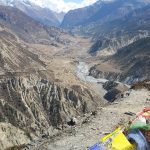
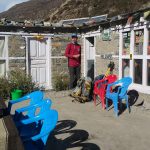
We set off early and it was a magical day of walking. I’m not sure how far we walked but I loved it. Just before the 270-degree turn is the abandoned village of upper Khangsar which was eerie to see. The Detroit of Nepal. At the big viewpoint turn in the trail, Keith and I chowed down on cookies and running gel. We had bought at MEC GU ultra endurance energy gel in a 480g bulk container. It’s basically rocket fuel to be used in small dosages. I had read in one report that it instantly metabolizes into your blood at altitude. I had the sea salt chocolate and it does really work. We also had a small jar of peanut butter and honey that made for a nice snack.
After about an hour we were both on the low side of our energy spike. Off in the distance, we could see a suspension bridge and tea house. The tea house was just a small restaurant. I’m so happy she was open and cooked us up a plate of pasta. Off to Ledar we pressed. We walked through what looked like a very nice town Yak Kharka. It was too bad we did not stop. The tea houses looked nice. Ledar has a poor selection of dirty tea houses. The one we stayed at was dirty and did add a “service charge” to our bill that I did not know about until after. They get the prize for the dirtiest toilet in Nepal. It was so gross. It would have been good to have a spray bottle of bleach. We did not have breakfast there but pushed on with empty stomachs to Thourung Phedi (4450m) which was so nice. The operator here knows how to keep people happy. I would have liked to have stayed there but we thought we would just push on over the pass that day.
So after a great brunch, we headed off to basecamp. The climb up was deceptive. It was as steep as the Tilicho lake trail. We made it up to base camp (4925m) at about 1 pm and decided to get a room for the night. Basecamp was a fun spot to stop. There was the gang from Tilicho lake base camp and various guided groups to visit with. The young Israeli ex-soldiers were surprised that we had made the same time as them to Ledar.
Most think it’s impossible to sleep at basecamp. We slept until the mouse woke me. I had pre-made up a bag of cookies with peanut butter on them and had a few cookies left in the wrapper when he struck. There is a mouse highway from room to room. I’m sure they were all chatting about the peanut butter cookies and seemed to come out in waves. After hiding my cookies in the bottom of my pack and putting the leftovers outside I went back to sleep.
At about 4 am the doors started to open and close. Keith and I were amped up for the pass so we shot out of bed and went for breakfast. We were in a good mood but some were not. One lady, in particular, took a strip off Keith for being happy and chipper. I think she was really hurting from the altitude. Keith had been taking Diamox and feeling good. The altitude did not bother me. It’s the one advantage of being over 50 – our brains have shrunk and have lots of empty room to expand in our skulls! All those years of killing brain cells finally paid off.
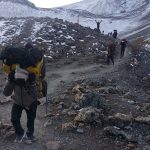

At about 5 am we set off in the dark. It was an out of body experience. It did not seem real. As you looked way up the trail all you could see was a line of headlights shining down and the same behind us. I have never hiked in the dark before with a headlamp on a steep trail. The odd thing was this was the first time we ran into the horse tow trucks. Literally, people make a living walking horses up to the pass and picking people up. I have no idea what they charge but it was odd. We saw lots jump on the horses. Most had tiny day packs and were on guided tours with porters and all. You could spot them in the tea houses because they had clean clothes on. They were the clean people as opposed to those with only extra socks and underwear. That day I had on my merino long johns, merino shirt, track pants and my MEC Tremblant down jacket and toque.
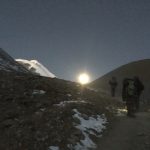
It was about -10 celsius when we started out. Yes, I’m so glad we bought quality MEC down jackets. As we got closer to the pass the sun came out. It was pretty interesting but, in my mind, not that great. It was kind of overrated and over-anticipated. The journey is what was great not going over the pass. Yes, Thorong La Pass is 5416m and we made it to the top.
At the top, it was a selfie mecca for all the guided tours. As we had made our way up we had walked with a group of young 15-16-year-old porters with massive packs. At the top, there was a little add hock tea shop. Most of the porters were just standing there. I started to hand out my cookies to them. At the same time, this older Korean man went into the tea house and put down a $20 US bill and ordered a coffee for all the porters. The porters, myself and the Korean man had a moment on the top. The Korean man was about 70 or so and had probably seen hardship in his life and was very gracious. It was odd seeing the tour people with their two-pound day packs taking photos of their group accomplishment of riding a horse and or having a porter drag their stuff to the top and not including the porters in their photos. It must be one of those middle class working Canadian things but seeing the porters’ struggle with those massive packs bothered me so much. Regulated maximum weights would perhaps not be a bad thing.
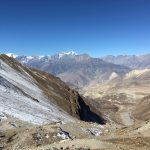
We did not stay long at the top – less than 5 minutes – and we booked it out of there. The trip down the backside is long and steep. In about 5 or 6 km you drop from the 5400 m to 3800 m. It’s like walking down the biggest mountain with about a mile drop down. Since the big disaster of 2014 when 40 or so died up there the government has built snow shelters on the back side. I do feel for anyone that has to use these because many have used as an outhouse. It would be a nasty night in the poopy buildings.
The trip down was worse than running a marathon. I was totally spent by the time we got close to the bottom. In the distance, you could see a town and it was miles away and it looked like we would never make it. Later I found out the town we could see was not where we were going. The town in the distance was Jhong. Where we were headed was the Bob Marley hotel in Rainpauwa just outside of the gates of Muktinath.
All the Israelis could talk about was the Bob Marley. Keith wanted to stay there. He had suggested I might want to stay somewhere else. He had made a few friends and wanted to be outside of the father-son gang. I could hardly blame him. There were lots of young pretty girls from around the world and he wanted to party with them all. I made a deal with him and would give him his space at the hotel. Needless to say, we spent a lot at the Bob Marley over the two days we were there. The food was the best in town.
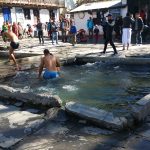
I was not really into going to see any religious sites but Keith talked me into seeing Muktinath. It was very cool to see. So glad I went. The day before as we came down off the mountain the trail goes right by there and I was totally spaced out and could not comprehend it. Like I said it was like a marathon and by the time we made it to town it was a dream. Muktinath is a major pilgrimage site for Indians who come up via jeep and stay at some of the high-end hotels in town. For us, it was so warm but those poor Indian were all freezing and dying from the elevation. The locals have horses that shuttle the Indians from the hotels to Muktinath. Muktinath is basically a walled site with various temples within the main site. There is methane coming out of the ground and has been burning for 3000 years hence all the sites. At one place they have to shower in the holy water. It was odd all the tourist taking pictures of the Indians on their pilgrimage.
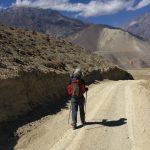
The next day all of Keith’s friends departed and the Bob Marley was quiet. So the next morning, after we had laundry done, we set off for Kagbeni (2800m) which we thought would be a cakewalk. It was not. From Jhong to Kagbeni -there was nothing. It was a moonscape. Once the day warmed up, the wind picked up. By the time we staggered into Kagbeni the wind had to be gusting up to 70 kmph. The rocks and/or sand was pelting us as we marched the last km into town.
The one downfall of our trip was not having the lonely planet guide book. We were out of gas when we got to town and the selection of accommodations sucked. The town had no power. We took what we could find. We tried to have a brief nap but the owner and his wife were screaming at each other outside of our door on the main floor. So we went out to tour the ancient town. We did find the statue of Viagra man and went to see the amazing Tibetan monastery.
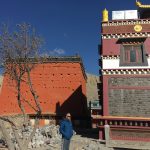
That night we found the McYakdonalds and had a McYak burger which was fantastic. Back at the noisy tea house, it was quite the show being on the ground floor and having the goat herd and then cattle come home. The other thing about the town was the Maltese dogs running wild. We had a Maltese about 15 years ago and he had a wild streak in him and now I know it was legitimate. They own the town. It was odd to see the gang of them.
The next morning, we left without breakfast and then ran into hotel alley on the outside of town. All the nice tea houses were along here. We had breakfast at one and it was fantastic. The Lonely Planet guide would have pointed this out. Andree’s book is more about the trails and he does not like to rank and or promote and tea houses.
The trail to Jomson was not exciting except we did pass a massive line of rented jeeps in some kind of rally. By the time we reached Jomson we were done. The trail goes right by the bus station. A couple from Austria we met had bought tickets so we got in line and bought tickets to Tatopani. We had heard so much about the hot springs it was like a desert mirage. The bus ride was out of this world. It was the roughest road I have ever been on.
We got in later and found a nice tea house. We went to the walk around town and see the sights. Keith wore his flip-flops and promptly cut his toe open. I went to the hot springs. It was bad very bad. Normally I’m not going to complain but hot water and no sanitizer makes for germs and it was like a sewer. I only basically stayed in for a few minutes. It was a total let down. When there is a layer of algae growing, you know there is not enough overturn of the water. The pools need to be drained and spayed with bleach. I spent 10 years in the hot tub business and do know all about water chemistry and that was bad. Sure enough that night I was sick with a fever. I did not have a thermometer but burned up. At about 3 am I woke in a soaked sleeping bag the fever broke. Keith poured me onto a bus at about 8 am. At about 4 or so we landed in Pokhara.
Basically, that was the end of our trip. We spend 4 days in Pokhara recouping. Thank god for “Fresh Elements” restaurant which is top rated on TripAdvisor and so good. Other than buying some Xanax for the flight home – which was dicy but worked so well – the rest is all history.
Thanks, Keith Simmons for going with me. There is something very satisfying about seeing your child turn into an adult.
Cheers Scott Simmons
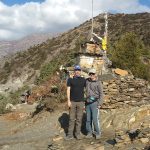

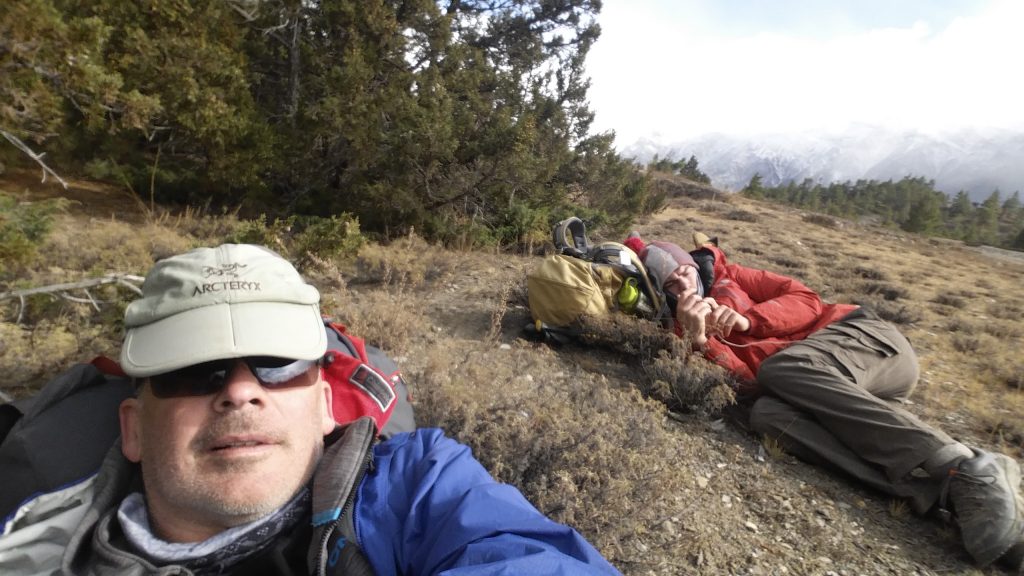
my oh my – I felt like I am there already.
Thank you so so much for this and I am sure it will help a lot of people who are planning.
Thank you again.